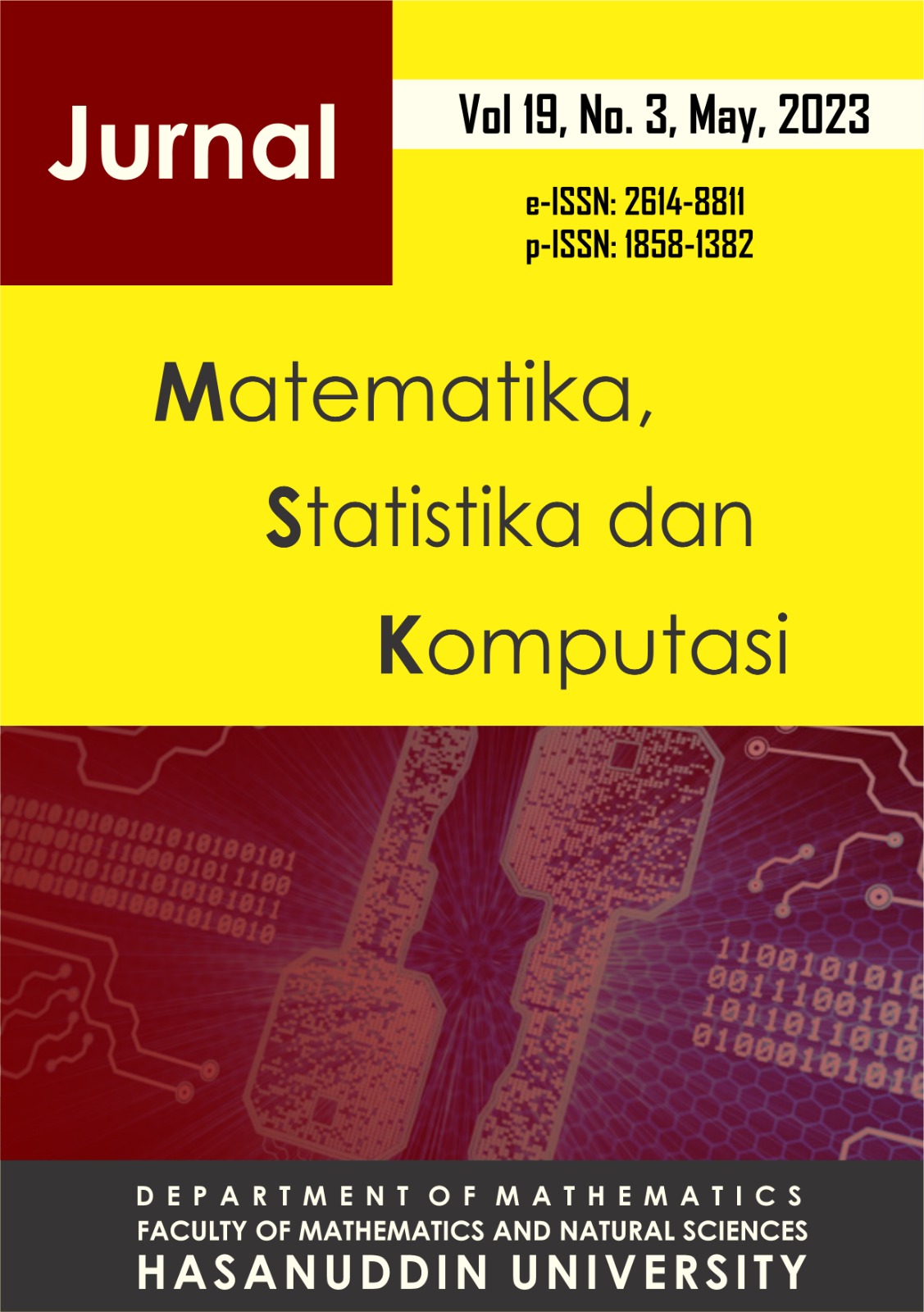Multinomial Logistic Regression To Model The Combination Of Phdi Status And Hdi Status Of Districts/Cities In Kalimantan Island
DOI:
https://doi.org/10.20956/j.v19i3.22299Keywords:
PHDI, HDI, LRT, MLE, Newton-Raphson, MLR, Wald testAbstract
Multinomial Logistics Regression (MLR) is a regression model developed from the Binary Logistics Regression (BLR) model. The response variable of the RLM model has three or more categories and has a multinomial distribution, with the data scale being nominal. The response variable in this study is a combination of the Public Health Development Index (PHDI) status and the Human Development Index (HDI) status of districts/cities in Kalimantan Island, 2018, divided into four categories with category one as a comparison. The predictor variables used were the number of the public health center, the percentage of poor people, economic growth, the pure junior high school participation rate, and the percentage of the population with a minimum of junior high school education. The MLR parameter model was estimated using the Maximum Likelihood Estimation (MLE) method and Newton-Raphson iteration. The hypothesis testing of the MLR model was used by the Likelihood Ratio Test (LRT) method and the Wald test. The best model selection in this study uses the backward method, and the interpretation of the best MLR model uses the odds ratio value. The results showed that the best MLR model is a model that has three predictor variables. The factors that significantly influenced the combination of PHDI status and the HDI status of districts/cities in Kalimantan Island in 2018 were the percentage of poor people, economic growth, and the percentage of people with the minimum level of education in junior high school.Downloads
References
Agresti, A., 2013. Categorical Data Analysis. New York: John Wiley & Sons.
Badan Pusat Statistik.,2019. Indeks Pembangunan Manusia 2018. Jakarta: BPS.
Bilder C. R. & Loughin T. M., 2015. Analysis of Categorical Data with R. CRC Press, Boca Raton.
Bohning, D., 1992. Multinomial Logistic Regression Algorithm. Ann. Inst. Statist. Math, Vol. 44, No. 1, 197 – 200.
Fibriyani V., Latra I. N. & Purhadi., 2015. Geographically Weighted Multinomial Logistic Regression Model (Case Study: Human Development Index Value and Healths Status Areas of Districts/Cities 2013 in Sumatera. Proceedings of the IconSSE FSM SWCU (pp. 13-19). Salatiga, Indonesia: FSM SWCU.
Garson G. D., 2014. Logistic Regression: Binary & Multinomial. Statistical Associates Publishing, North Carolina.
Hosmer D. W., Lemeshow S., & Sturdivant R. X., 2013. Applied Logistic Regression. John Wiley & Sons Inc., New Jersey.
Kementerian Kesehatan., 2010. Indeks Pembangunan Kesehatan Masyarakat. Badan Penelitian dan Pengembangan Kesehatan, Jakarta.
Kementerian Kesehatan., 2019. Indeks Pembangunan Kesehatan Masyarakat. Badan Penelitian dan Pengembangan Kesehatan, Jakarta.
Kutner M. H., Nachtsheim C. J., & Neter J., 2004. Applied Linear Regression Models. McGraw-Hill/Irwin, New York.
Pawitan Y., 2001. All Likelihood: Statistical Modelling and Inference Using Likelihood. Clarendon Press, Oxford.
Seidu A. A., 2021. A Multinomial Regression Analysis of Factors Associated with Antenatal Care Attendance Among Women in Papua New Guinea. Public Health in Practice, Vol. 2, No. 100161, 1 – 7.
Suyono., 2015. Analisis Regresi Untuk Penelitian. Deepublish, Yogyakarta.
Yanagihara K., Kamo, K., Imory, S., & Satoh, K., 2012. Biased-corrected AIC for Selecting Variables in Multinomial Logistic regression models. Linear Algebra and Its Applications, Vol. 436, 4329 – 4341.
Downloads
Published
How to Cite
Issue
Section
License
Copyright (c) 2023 Author and publisher

This work is licensed under a Creative Commons Attribution 4.0 International License.

This work is licensed under a Creative Commons Attribution 4.0 International License.
Jurnal Matematika, Statistika dan Komputasi is an Open Access journal, all articles are distributed under the terms of the Creative Commons Attribution License, allowing third parties to copy and redistribute the material in any medium or format, transform, and build upon the material, provided the original work is properly cited and states its license. This license allows authors and readers to use all articles, data sets, graphics and appendices in data mining applications, search engines, web sites, blogs and other platforms by providing appropriate reference.








